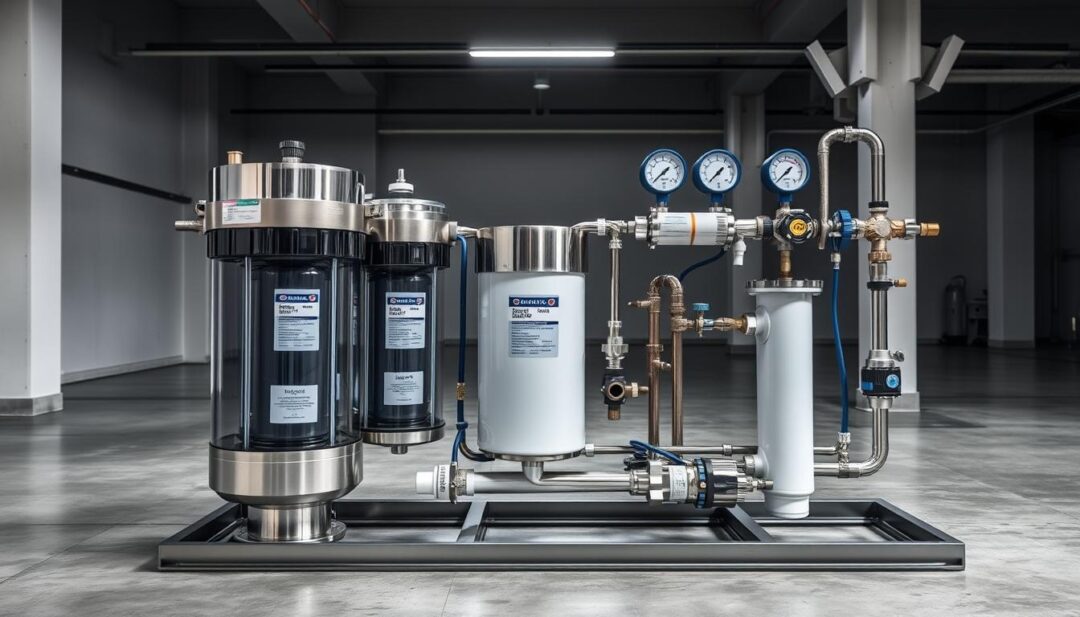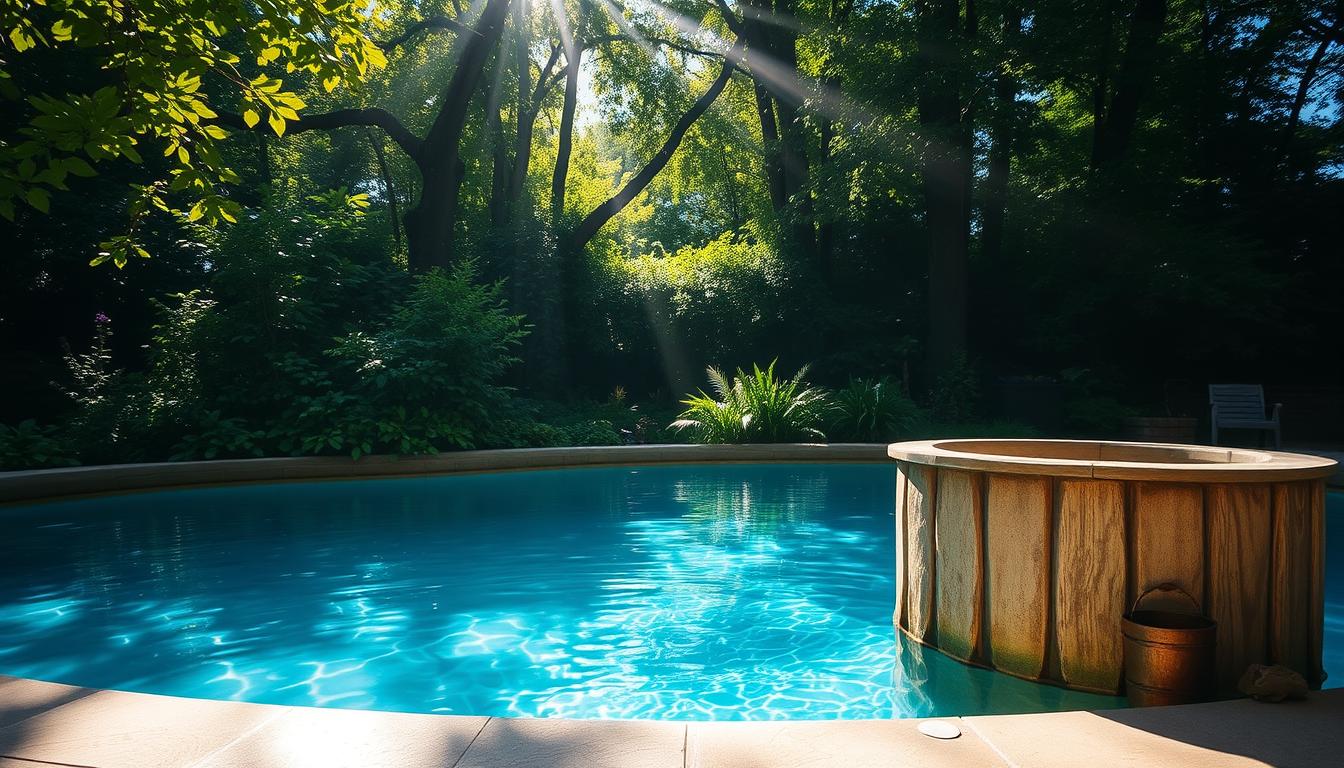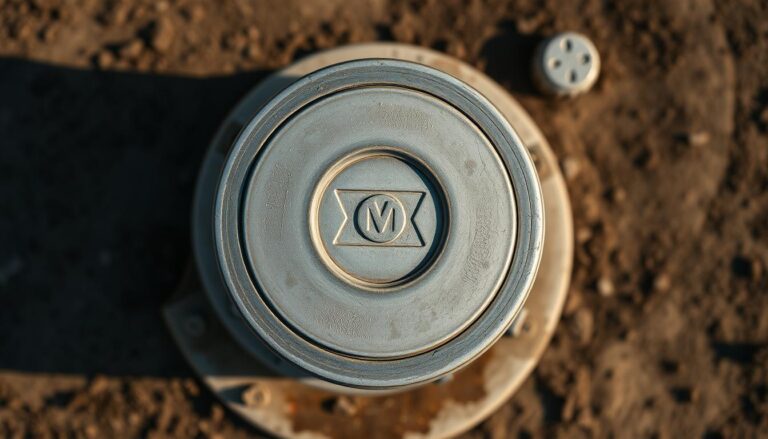Using Well Water in Your Pool: What to Know
Are you considering using well water to fill or top off your pool? You’re not alone. Many pool owners are exploring this cost-effective option. But is it safe and efficient for your swimming pool?
Filling your pool with well water can be a viable alternative to municipal water, but it’s crucial to understand the implications. Well water can contain various minerals and contaminants that may affect your pool’s chemistry and equipment.
Before making the switch, it’s essential to weigh the pros and cons and learn about the necessary testing and treatment procedures to ensure your pool remains safe and clean.
Key Takeaways
- Well water can be a cost-effective option for pool filling.
- Proper testing is necessary to identify potential contaminants.
- Treatment may be required to adjust the water’s chemistry.
- Using well water can impact your pool’s equipment and maintenance.
- Understanding the pros and cons is crucial before making a decision.
Understanding Well Water Composition
Understanding the makeup of your well water is the first step in maintaining a healthy and safe pool environment. Well water can contain a variety of minerals and substances that are not typically found in municipal water supplies. These can include iron, manganese, calcium, and other metals.
Common Minerals Found in Well Water
Well water often contains minerals such as iron and manganese, which can cause staining and discoloration in pools if not properly treated. Calcium is another common mineral that can affect the water’s hardness and overall chemistry. Regular testing is necessary to determine the levels of these minerals.
Regional Variations in Well Water Quality
The quality of well water can vary significantly depending on the region and local geology. For instance, areas with high levels of iron ore in the ground may have well water with elevated iron content. Understanding these regional variations is crucial for effective pool maintenance.
How Well Water Differs from Municipal Water
Unlike municipal water, which is treated and regulated to meet specific standards, well water is not subject to the same level of treatment. This means that well water can contain higher levels of minerals and other substances that may require additional treatment before use in a pool.
Can You Use Well Water in a Pool?
Well water can be a viable option for filling your pool, provided you understand its composition. The suitability of well water for pool use depends on various factors, including its chemical makeup and the presence of minerals or contaminants.
The Short Answer: Yes, With Proper Treatment
Yes, you can use well water in your pool, but it requires proper treatment to ensure it’s safe and healthy for swimming. Proper treatment involves testing the water quality and applying appropriate treatments to adjust its chemical balance and remove any harmful substances.
Factors That Determine Suitability
Several factors determine whether well water is suitable for your pool. These include the water’s pH level, alkalinity, calcium hardness, and the presence of metals like iron and manganese. Testing the water is crucial to understand its composition and identify necessary treatments.
When Well Water Might Not Be Suitable
There are situations where well water might not be suitable for pool use, such as when it contains high levels of certain contaminants or minerals that are difficult or expensive to remove. In such cases, alternative water sources or advanced treatment systems may be necessary.
To ensure your pool water is safe and enjoyable, it’s essential to carefully evaluate your well water’s quality and apply the necessary treatments. Regular testing and maintenance are key to a well-functioning pool.
Testing Your Well Water Before Pool Filling
Testing your well water is a critical step before filling your pool. This process helps determine the water’s chemical composition and identify potential issues that could affect your pool’s maintenance and safety.
Essential Water Parameters to Test
When testing your well water, several key parameters should be evaluated. These include pH levels, alkalinity, calcium hardness, and the presence of metals like iron and manganese. Testing for these parameters helps you understand the water’s overall quality and its potential impact on your pool.
DIY Testing vs. Professional Analysis
You have two primary options for testing your well water: DIY testing kits and professional analysis. While DIY kits are convenient and cost-effective, they may not provide the comprehensive results that a professional analysis can offer. For a more detailed understanding of your well water’s composition, consider hiring a professional to conduct the testing. For more information on testing your well water, you can visit this resource.
Interpreting Test Results
Once you have your test results, interpreting them correctly is crucial. Look for any parameters that are outside the recommended ranges for pool water. If you find any issues, such as high levels of certain minerals, you’ll need to plan for the necessary treatments to adjust the water chemistry accordingly.
By thoroughly testing your well water and understanding the results, you can ensure a safe and enjoyable pool experience. Proper testing and treatment are key to maintaining a healthy pool environment.
Preparing Well Water for Pool Use
Before filling your pool with well water, it’s essential to prepare it properly to ensure a safe and enjoyable swimming experience. Well water can contain various minerals and impurities that may affect your pool’s water quality and equipment.
Pre-Treatment Options
Pre-treatment is a critical step in preparing well water for pool use. This may involve:
- Shock treatment to oxidize organic matter
- pH adjustment to bring the water within the ideal range
- Alkalinity adjustment to stabilize the water
Filtration Systems for Well Water
A suitable filtration system is vital for removing impurities from well water. Options include:
- Cartridge filters for smaller particles
- Diatomaceous earth (DE) filters for finer filtration
- Sand filters for larger debris

Water Softening Considerations
If your well water is particularly hard, water softening may be necessary. This process involves removing calcium and magnesium ions, which can cause scaling and damage to your pool equipment. Consider the following:
- Ion exchange systems for effective softening
- Alternative methods like magnetic or electronic water conditioners
By addressing these aspects, you can ensure your well water is properly prepared for use in your pool, providing a safe and enjoyable swimming environment.
Filling Your Pool with Well Water
The process of filling a pool with well water involves several key steps to ensure the water is safe and suitable for swimming.
Best Practices for Initial Fill
Before filling your pool with well water, it’s essential to test the water quality. This includes checking for minerals, metals, and other contaminants that could affect the pool’s chemistry and equipment.
Monitoring Water Levels During Filling
During the filling process, it’s crucial to monitor the water level closely to avoid overfilling, which can lead to costly repairs.
Impact on Your Well System
Filling a pool with well water can put a significant strain on your well system. It’s vital to assess your well’s capacity and consider consulting a professional to ensure it can handle the demand.
By following these guidelines, you can enjoy a safe and enjoyable swimming experience with your well water pool.
Balancing Well Water Chemistry
The unique composition of well water requires careful balancing of pool chemicals to ensure optimal swimming conditions. Well water can contain various minerals and impurities that affect the pool’s chemistry, making it essential to monitor and adjust the chemical levels regularly.
Adjusting pH Levels
The pH level of your pool water is crucial for swimmer comfort and equipment longevity. Well water can have a high or low pH, so it’s essential to test it regularly and adjust it as needed. The ideal pH range for a pool is between 7.2 and 7.8.
Managing Alkalinity
Alkalinity acts as a buffer to pH changes, helping to maintain stable water conditions. Well water with high alkalinity can lead to scaling issues, while low alkalinity can cause pH fluctuations. Regular testing and adjustments are necessary to keep alkalinity within the recommended range of 80-120 ppm.
Calcium Hardness Considerations
Calcium hardness is another critical factor in well water pool chemistry. Low calcium hardness can lead to etching of plaster surfaces, while high levels can cause scaling. The ideal range for calcium hardness is between 200-400 ppm for plaster pools.
Stabilizer and Cyanuric Acid Levels
Cyanuric acid (CYA) helps stabilize chlorine in the water, protecting it from degradation by UV light. Well water pools need to maintain an optimal CYA level between 30-50 ppm to ensure effective chlorine use.
| Chemical Parameter | Ideal Range |
|---|---|
| pH | 7.2 – 7.8 |
| Alkalinity | 80 – 120 ppm |
| Calcium Hardness | 200 – 400 ppm |
| Cyanuric Acid (CYA) | 30 – 50 ppm |
By carefully managing these chemical parameters, well water pool owners can ensure a safe, healthy, and enjoyable swimming environment. Regular testing and adjustments are key to maintaining optimal water chemistry.
Common Well Water Pool Problems
Well water, while a viable option for pool filling, often presents unique problems that need addressing. Pool owners may encounter issues such as staining, unpleasant odors, and water discoloration due to the presence of various minerals and substances.
Dealing with Iron and Staining
Iron is a common contaminant in well water that can cause staining on pool surfaces. To address this, oxidizing agents can be used to remove iron from the water. Regular testing for iron levels is crucial.
Managing Manganese Issues
Manganese, another mineral found in well water, can lead to discoloration and staining. Using a manganese-removing filter or a water treatment product designed to handle manganese can mitigate these issues.
Addressing Sulfur Odors
Sulfur in well water can produce a characteristic “rotten egg” smell. Activated carbon filters or oxidizing shock treatments can help eliminate sulfur odors from pool water.
Handling Tannins and Discoloration
Tannins, which can cause water to appear brown or tea-colored, are another challenge. Using a tannin-removing product or adjusting the pool’s pH can help clarify the water.
| Issue | Cause | Solution |
|---|---|---|
| Staining | Iron | Oxidizing agents, regular testing |
| Discoloration | Manganese | Manganese-removing filters, water treatment products |
| Sulfur Odors | Sulfur | Activated carbon filters, oxidizing shock treatments |
| Tannins | Organic matter | Tannin-removing products, pH adjustment |
By understanding these common problems and implementing the right solutions, pool owners can enjoy their well water-filled pools without significant issues.
Special Equipment for Well Water Pools
Specialized equipment is crucial for well water pools to manage water quality effectively. The unique characteristics of well water can pose challenges for pool maintenance, but with the right gear, you can ensure a safe and enjoyable swimming experience.
Specialized Filtration Systems
One of the key pieces of equipment for well water pools is a specialized filtration system. These systems are designed to handle the higher levels of minerals and contaminants often found in well water. Options include cartridge filters, DE filters, and advanced systems like nanofiltration or ultrafiltration.
Pre-Filters and Sediment Traps
Pre-filters and sediment traps are essential for capturing larger particles and debris before they enter your pool system. This helps protect your main filtration system and pumps from damage, ensuring more efficient operation.

Water Treatment Injectors
Water treatment injectors allow you to add specific chemicals directly into your pool water to address issues like pH imbalance, algae growth, or metal contamination. These systems provide precise control over your water chemistry.
Automatic Chemical Controllers
Automatic chemical controllers take the guesswork out of maintaining your pool’s chemical balance. These systems continuously monitor your water’s pH, chlorine levels, and other factors, making adjustments as needed to keep your pool water safe and clean.
By investing in these specialized equipment pieces, you can effectively manage the challenges associated with well water pools and enjoy a well-maintained, safe swimming environment.
Troubleshooting Well Water Pool Issues
Resolving issues with well water pools involves understanding the causes and applying effective solutions. Well water pool owners often encounter unique challenges, but with the right approach, these problems can be managed.
Cloudy Water Solutions
Cloudy water is a common issue in well water pools, often caused by high levels of minerals or contaminants. To clear the water, start by testing the pH and alkalinity levels. Adjusting these parameters can help resolve the issue. If the problem persists, consider using a clarifier or flocculant to remove suspended particles.
Addressing Persistent Staining
Staining in well water pools is typically caused by iron or manganese. To address this, use a metal sequestrant to bind with the metals and prevent them from causing stains. Regularly cleaning the pool surfaces and maintaining proper water chemistry can also help prevent staining.
Fixing Pump and Filter Problems
Pump and filter issues can lead to poor water circulation and filtration. Regular maintenance, such as cleaning the filter and checking for blockages, can help prevent these problems. Ensure that the pump is properly sized for your pool and that it’s running efficiently.
When to Drain and Refill
If your well water pool is experiencing persistent problems that can’t be resolved with treatment or maintenance, it may be time to drain and refill. This can help reset the water chemistry and remove built-up contaminants. However, this should be done judiciously, as it can be costly and wasteful.
Seasonal Maintenance for Well Water Pools
Maintaining a well water pool requires attention to seasonal changes to ensure the water remains safe and healthy. Proper maintenance involves a series of tasks that vary by season.
Spring Opening Procedures
When opening your well water pool in the spring, start by inspecting the pool and its equipment for any damage or debris accumulated during the winter. Check the pool maintenance systems and ensure they are functioning correctly.
Summer Maintenance Routine
During the summer, regularly test the water chemistry and adjust as necessary to maintain optimal levels. Keep an eye on the water level and top it off as needed due to evaporation.
Fall Closing Best Practices
When closing your pool in the fall, thoroughly clean the pool and equipment, and balance the water chemistry to prevent damage during the off-season. Consider using a pool cover to protect the pool from debris.
Cost Considerations: Well Water vs. Municipal Water
When considering using well water for your pool, it’s crucial to understand the cost implications compared to municipal water. The decision involves evaluating both initial expenses and long-term maintenance costs.
Initial Treatment Expenses
Using well water in your pool often requires initial treatment to adjust the water chemistry. This can include expenses for testing kits, pre-treatment chemicals, and specialized filtration systems. The cost of these initial treatments can vary depending on the quality of your well water.
Long-Term Maintenance Costs
Long-term maintenance costs for well water pools can be higher due to the need for ongoing chemical balancing and equipment maintenance. Regular testing and adjustments are necessary to maintain safe and healthy swimming conditions.
Potential Savings with Well Water
Despite higher maintenance costs, using well water can offer potential savings. For instance, you can avoid municipal water fees, which can be substantial, especially for large pools. The table below compares some of the key cost factors between well water and municipal water pools.
| Cost Factor | Well Water | Municipal Water |
|---|---|---|
| Initial Fill Cost | $0 (if well exists) | Variable (water fees apply) |
| Treatment Costs | Higher (specialized treatment needed) | Lower (pre-treated water) |
| Maintenance Costs | Higher (frequent testing and balancing) | Lower (less frequent adjustments needed) |
In conclusion, while there are both initial and long-term costs associated with using well water in your pool, there are also potential savings to be considered. Carefully evaluating these factors will help you make an informed decision.
Conclusion
Using well water in your pool can be a cost-effective and sustainable option, but it requires careful consideration and maintenance. As discussed, understanding the composition of your well water is crucial before filling your pool.
Proper testing and treatment are essential to ensure the water is safe and healthy for swimmers. Regular maintenance, including balancing water chemistry and addressing common issues like iron staining, will help keep your pool in optimal condition.
By following the guidelines outlined and implementing well water pool solutions, you can enjoy a refreshing and safe swimming experience. Whether you’re filling your pool for the first time or maintaining an existing one, being informed about the specifics of using well water can make all the difference in the longevity and enjoyment of your pool.
Can you use well water in a pool? Yes, with the right precautions and ongoing care, well water can be a viable option for pool owners, offering a unique set of benefits and challenges that require tailored well water pool solutions.







